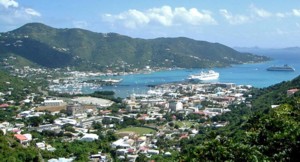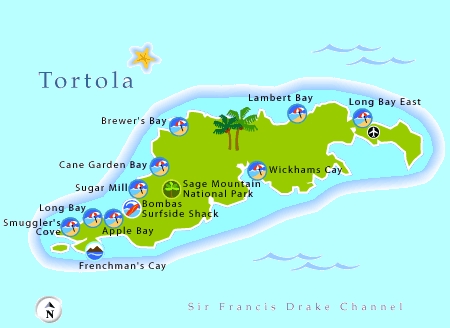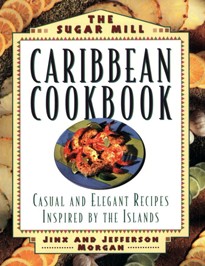By Nancy Gerlach
 Roadtown, Tortola, BVI |
Recipes: –Lemon Crash |
Tortola! Just the name conjures up images of pirates and rum, gold doubloons, and sunken treasure. After all, this island paradise not only served as the setting for Robert Louis Stevenson’s Treasure Island, but the infamous pirate Blackbeard did indeed maroon fifteen men on a small deserted island here with only a sea chest, a sword, and a bottle of rum. The islands, which lie almost within shouting distance of each other, were originally named by Christopher Columbus when, on his second voyage to the New World, he spotted them and was reminded of the legendary St. Ursula surrounded by her 11,000 virgins, thus the Virgin Islands.
Dubbed “Natures Little Secret,” this area has been a sailor’s paradise for many years. The islands themselves serve as a barrier for the trade winds, allowing only the gentle breezes to circulate over and between the islands. This not only keeps the temperature at a steady 80 to 90 degrees, but also provides some of the best sailing in the Caribbean. And maybe because of their popularity among the sailing crowd, the British Virgin Islands have never promoted mass tourism. So, don’t look for high-rise hotels, gambling casinos, and glitzy nightclubs; in fact, much of the BVI remains much as Columbus–and the pirates who followed him–first viewed them. However, if you love to sail, snorkel, scuba dive, hike, or just savor miles of gorgeous deserted white sand beaches–this is the place for you! Relaxing and enjoying nature at its most beautiful, with some of the friendliest people in the Caribbean is the charm of the BVI.
Although the BVI have long catered to the yachting and sailing set, accommodations are varied enough to suit all budgets. There are five-star resorts and fabulous villas as well as live-aboard sailboats and yachts that can be charted. But there are also moderately priced hotels and inns, and even a few campsites. Wind surfers can take advantage of vacation packages which includes a room on a boat that sails to all the best surfing sites. At the Bitter End Yacht Club they can arrange environmental geared vacations for those interested in studying life both above and below the sea. And Necker Island, host to guests such as Princess Di and Oprah Winfrey, is available for around $10,000 a day; a testament to the unbelievable beauty of the BVI.

Beach Map Courtesy of reservationsbvi.com
Traditional BVI cuisine, like most of the Caribbean, has been shaped and influenced by a mix of peoples from Europe, Asia, and Africa and by the available resources. Fish and shellfish are, of course abundant; chicken is prepared in a variety of ways; pork and goat are reserved for special occasions. Coconuts, mangos, papayas, and bananas abound along with more exotic fruits such as soursop, guava, and sugar apples. Unusual vegetables include breadfruits, strange-looking root crops like dasheen and taro, a wide variety of pumpkins, christophene (chayote), and the leaves of the dasheen, which resemble spinach and are used in the popular Caribbean soup, callaloo. Although the islands are British, the English probably have had the smallest impact on the cuisine. The Dutch, by way of Indonesia, brought spices to the area, and the contribution of the surrounding Spanish islands is easily seen in the creole sauces I saw on menus, and in the present day, the cuisine is still evolving. Today more of the island people are traveling and working in kitchens, spreading their culinary heritage throughout the Caribbean islands. All the British islands–Barbados, Jamaica, and Trinidad primarily–have hot food, but, according to a number of chefs, in the BVI the island where it is really hot is Guana.
 Scotch Bonnets |
 Bird Peppers |
There are two hot chiles used in the BVI–Scotch bonnets and bird peppers. The bird pepper is a small annuum or frutescens pod type that grows wild throughout the islands, and Scotch Bonnets are cultivated in backyard gardens, but neither are grown commercially. Jinx and Jeff Morgan, owners of the Sugar Mill Hotel and columnists for Bon Appetit magazine, told me that when they moved to the BVI fourteen years ago, they thought the multicolored bird peppers so pretty that they used sprigs of the chiles to garnish plates in their restaurant. That lasted until one of their guests proceeded to eat the garnish, and they learned just how hot they were. Now they enjoy cooking with the chiles, but no longer run the risk of setting their guests on fire by using them as a garnish!
 Sugar Mill Hotel |
 Sugar Mill Cookbook |
A common use for Scotch bonnets is in a home-style recipe for hot sauce which consists of the chile, garlic, onion, salt, and vinegar. The chopped ingredients are placed in the vinegar and allowed to steep or marinate to build up the heat in the sauce before it is used at the table. Another way they are used is in a combination that Chef Angus Bowen of the Bitter End Yacht Club called “island seasoning.” Chiles, along with celery and herbs are placed in a blender with a little vinegar and processed until smooth. This very concentrated sauce is used to season fish or meat, and since any combination of herbs can be used, results can vary widely. Some of the herbs used in BVI cooking are fever grass (lemongrass) imported from St. Vincent or Jamaica, thyme, rosemary, and parsley. Basil is grown but is used as a bush tea rather than a seasoning.
The hot sauce of choice in the BVI is one from St .Vincent called Erica’s, and it was everywhere. Alson Pont of Peter Island cooks with fresh chile or “a little Erica’s if necessary,” and it didn’t take me long to realize that it was almost always necessary! Other chiles are also starting to make their way into the cooking. Chef Rick Butaffuso, has introduced jalapeños and chipotles into his recipes at the Sugar Mill.
Before I visited the BVI I wasn’t sure what I’d find in the way of hot and spicy, but I was in for a pleasant surprise. In most restaurants, you can dine on wonderfully prepared spicy food, while enjoying magnificent views in an informal or casual atmosphere. Many of the chefs I met had trained in Europe and are now combining traditional ingredients and cooking techniques with Caribbean foods and cooking styles. And more and more West Indian and traditional foods are appearing on restaurant menus. The food changes as the demand dictates, so as more tourists request traditional and hot and spicy foods, more is served. At Peter Island Resort, for example, a majority of their American guests are no longer looking for just hamburgers, instead they want to sample Caribbean fare. If guests request hot and spicy food, they are happy to accommodate, and they even have a Caribbean cookout on the beach. George Aquino, Director of Food and Beverage, also has plans to start a salsa bar!
And the culinary fame of the BVI is spreading. Earlier this year in Puerto Rico, the BVI were big winners in a culinary competition at CHIC, the Caribbean Hotel Industry Conference. Although some teams included European chefs, the relatively tiny BVI team, which consisted of all Caribbean chefs, won numerous awards. They were recognized for both their skill and friendliness and won the award for being the “Team Most Personifying the Spirit of the Competition.” In addition, they picked-up silver medals for their appetizer, Seared Peppered Ahi Tuna with Christophine Ratatouille Laced with a Curry Essence and served with Plantain Chips; their soup, which was Caribbean Conch Consomme served with Sweet Potato Tortellis and Seaweed Twists; and their dessert, Coconut Phyllo Napoleon with Mango Mousse served with Caribbean Cocoa and Passion Fruit Sauce. They also won a bronze medal in the centerpiece competition for Chef Manny Thompson’s “Watermelon Waterfall.”
So what’s cooking in the BVI? Interesting, exciting, and wonderful food and a cuisine that is evolving, as it always has, combining the best from many cultures.
Lime Crash

The Bitter End Yacht Club got the name because it is the last spot of land before the Atlantic Ocean and was the turn back point for Caribbean sailors. Today, with more than 100 yachts and watercraft, it has the world’s largest resort fleet. We were treated to these Bitter End original drinks after a long day in the hot sun. Tasty and refreshing, they can sneak up on you if you aren’t careful. The rum they used, Cruzan, comes from St. Croix where the natives are called Crucians, hence the name. Myers or any good rum can be substituted, even Prusser’s, the official rum of the British navy. To make a simple syrup, boil 2 parts sugar to 1 part water for 5 minutes.
4 ounces Cruzan or Myers Rum
6 ounces simple syrup
1/4 cup lime juice
4 8-ounce cups of ice
Lime slices for garnish
Divide the first 4 ingredients in half and place in a blender. Process until smooth. Pour into tall glasses, garnish with a lemon slice and cherry, and serve. Variation: Use ice cubes instead of crushed ice.
Yield: 2 servings
Stuffed Roti with Potato Curry

Rotis are traditional fare throughout the Caribbean and have been called a West Indian version of a burrito. The bread wrapper is East Indian in origin and always contains something curried. We enjoyed this dish at Foxy’s Tamarind Bar, an open-air, sand-floored restaurant on Jost Van Dyke Island, which is pronounced “yost” and named after a famous pirate. Foxy Callawood has been serving people for thirty years, and draws an amazing crowd that come for food, drink, and calypso, reggae, and soca music. We were fortunate that Foxy wasn’t on tour somewhere around the world, and we were serenaded by his songs which he composes on the spot.
Dough:
4 cups all-purpose flour
2 teaspoons baking powder
1 teaspoon salt
1 cup water
1/4 cup vegetable oil
Filling:
2 cloves garlic, minced
1 tablespoon minced garlic
1 Scotch bonnet chile, stem and seeds removed, minced or substitute 2 fresh cayenne chiles
1 to 2 tablespoons vegetable oil
1 onion, diced
3 tablespoons curry powder
1 teaspoon dried thyme
1/2 teaspoon ground cloves
1/2 teaspoon ground black pepper
1/4 teaspoon salt
3 cups cooked, peeled, diced potato
2 cups water
2 tablespoons tamarind paste dissolved in 1/4 cup water (optional)
1 15-ounce can garbanzo beans, drained
Vegetable oil for frying
To make the rotis, sift the dry ingredients together in a bowl. Gradually stir in oil and enough water to form a ball with the dough. Knead the dough for 5 minutes or until soft. Gather into a ball, cover and let rise for 15 minutes.
In a pan, saute the garlic, ginger, and chile in the oil for a couple of minutes. Add the onions and spices and saute until the onions are soft. Add the potatoes, water, tamarind, and garbanzo beans, and simmer for 15 minutes, until soft but not mushy.
Divide the dough into 4 equal balls. Flatten each and roll out into a circle, 8 to 9-inches in diameter. Heat 2 tablespoons of oil in a skillet until very hot (a drop of water will sizzle). Reduce the heat and place rotis in pan, cook for 2 to 3 minutes, until browned, turn and brown. Remove and cover with a towel until ready to serve.
To serve, place about a cup of the filling in the center of a roti. Fold over the sides and fold up the ends, as you would with a burrito. Serve accompanied with a chutney (see recipe below) and a hot sauce.
Yield: 4 servings
Heat Scale: Medium
Seared Tuna with Yellow Bell Pepper Sauce

Biras Creek is a low-key resort, accessible only by boat, on Virgin Gorda. The dining room has a 360-degree view that overlooks three bodies of water–the Atlantic Ocean, the Caribbean Sea, and the Sir Francis Drake Channel. Chef Earl Williams, who serves both Contiential and Caribbean cuisine, has shared this recipe. If tuna is not available, try substituting swordfish, mahi mahi, or shark.
1 tablespoon finely chopped shallots
1 clove garlic, minced
1 small sprig fresh thyme
1 tablespoon sweet butter or margarine
2 cups fish stock
2 yellow bell peppers, stems and seeds removed, chopped
3 to 4 tablespoons Scotch bonnet hot sauce
2 tuna steaks, fresh preferred
In a pan, saute the shallots, garlic, and thyme in the butter for a couple of minutes until soft but not browned. Add the sock and peppers and simmer for 20 minutes. Remove the thyme, pour the mixture into a blender and puree to form a smooth glossy sauce. Season with salt, pepper and hot sauce.
Sear the tuna steaks on a grill for about 3 minutes on each side until done.
Place the tuna on a plate and lightly cover with the sauce.
Yield: 2 servings
Heat Scale: Medium
Her Majesty’s West Indian
Regimental Chicken Curry

According to Jinx and Jeff Morgan, who shared this recipe, curries can be found throughout the West Indies. The English call it curry, the Dutch kerry, and the French colombo. After responding to a newspaper ad fourteen years ago, Jinx and Jeff wound up owning the Sugar Mill Hotel. The Mill, built on the remains of a 1640 plantation and rum distillery, abounds with history. For example, at the height of the slave/sugar/rum trade, ships which had left full for England, often had little cargo for their return trips to the islands. To provide ballast for the ships, crews would come ashore in the dead of night and remove cobble stones from the streets of Liverpool and other ports. The stones would then be used in construction on the islands, and some of them can be seen in the walls of the dinning room at the Sugar Mill. This small, romantic resort has a reputation in the Caribbean as a hotel and restaurant not to be missed.
The Curry:
2 onions, chopped
2 cloves garlic, minced
2 tablespoons minced fresh ginger
2 tablespoons butter or margarine
2 tablespoons curry powder, or more to taste
1/4 cup all-purpose flour
1 quart chicken broth
2 cups coconut milk
3 boneless chicken breasts, poached, skin removed
2 apples, peeled, cored and cut in chunks
Salt and pepper to taste
Cooked rice
The Condiments:
Chopped bananas
Fresh toasted coconut
Chopped green onions
Crisp crumbled bacon
Chopped tomatoes
Yogurt with chopped cucumbers
In a large pan, saute the onions, garlic, and ginger in the butter until soft. Add the curry powder and flour and cook gently for 5 minutes. Add the chicken broth, coconut milk and cook, stirring constantly, until mixture thickens, about 5 to 10 minutes. Strain the sauce.
Add the chicken and apples to the sauce and cook gently until the chicken is heated through.
Serve on rice accompanied by condiments of choice.
Yield: 6 servings
Heat Scale: Mild
Caribbean Crab-Stuffed Chicken with Almond Crust

Willo Stout likes to use local ingredients when developing recipes for the Peter Island Resort and Yacht Harbour. In this recipe, for example, he recalled that his mother used to prepare almond cakes using the local crop, so he added them to a batter to create this elegant dish. The resort offers a unique experience for those of us who enjoy cooking. Once a week a few of the resort guests can go behind the scenes and work, one on one, with the chefs, learning their techniques. It’s a rare treat for anyone who has not been in a commercial kitchen, and the staff is so friendly!
The Stuffing:
1/4 cup diced onion
1/4 cup diced celery
2 teaspoons chopped garlic
1 teaspoon minced Scotch bonnet chiles or substitute Caribbean pepper sauce
2 tablespoons butter or margarine
1 pound crabmeat
1/2 pint heavy cream
1 tablespoon Dijon mustard
Pinch minced fresh thyme
1/4 cup minced fresh parsley
Salt and pepper, to taste
The Crust:
2 cups finely chopped almonds
1/4 cup bread crumbs
The Chicken:
4 boneless, skinless chicken breasts
2 eggs, beaten
Flour for dredging
Preheat an oven to 350 degrees.
In a large pan, saute the onions, celery, garlic, and chile in the butter until soft. Add the crabmeat and cook for 2 two minutes. Stir in the cream, mustard, thyme and simmer for an additional couple of minutes. Remove from the heat, add the parsley and season with salt and pepper. Allow to cool.
Combine the almonds and bread crumbs in a bowl.
Pound the chicken to flatten to about inch thick. Spread the stuffing onto each breast and roll the breast. Dip each roll in the flour, then the eggs. Roll the chicken in the almond mixture and place on a baking pan.
Bake for about 10 minutes or until golden brown. Slice each roll into pieces about 1 inch thick, arrange on a plate and serve.
Yield: 6 to 8 servings
Heat Scale: Medium




